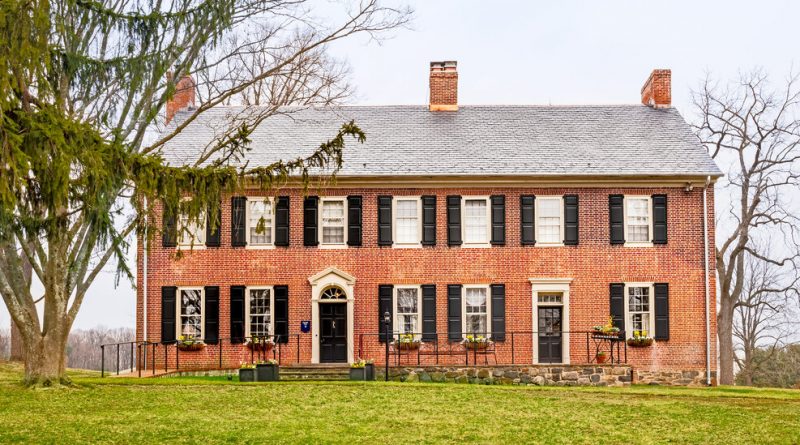A ‘Surprising and Unexpected’ Update at Winterthur
[ad_1]
When Carol B. Cadou was named the director and chief executive of the Winterthur Museum, Garden & Library in Delaware in April 2018, she began planning for total immersion in the 978-acre former estate of Henry Francis du Pont.
“When I came on board, the trustees asked if I would live on the property,” said Ms. Cadou, 52. “Of course, I was absolutely thrilled to think of bringing my family to Winterthur.”
But there was one issue: The house she would live in with her husband, Christopher Cadou, 55, a professor of aerospace engineering at the University of Maryland, and their children, Lilly, 13, and William, 10, was in need of attention.
The Federal-style brick building known as Chandler Farm, which Mr. du Pont had designated a residence for the museum’s director in 1958, hadn’t been used by museum staff for a decade. “It was being rented out,” as a private home, Ms. Cadou said, and had become as worn as the dog-eared pages of a well-loved novel.
By the time she arrived, the electrical, HVAC and fire-detection systems required updates, and the interior needed an overhaul. “It was almost overwhelming in its darkness, with old wallpaper on the walls and drapery that had seen better days,” Ms. Cadou said. The home’s collection of furniture — 1980s reproductions of pieces from Winterthur’s trove of American decorative arts — had been removed and scattered throughout other buildings on the grounds.
Ms. Cadou hoped to update the house, which was built in the late 18th and early 19th centuries, so it would function equally well as a family home and as a place to entertain museum guests. But she knew there were few funds available for renovation. “We have so many other needs around Winterthur,” she said. “We have 118 historic structures, and Chandler Farm is not the only one that needs attention.”
For help, she called on Thomas Jayne, a New York-based interior designer she had met in 1995 at an alumni event for the Winterthur Program in American Material Culture, from which they had both graduated.
Mr. Jayne, who has credited the institution as a major source of inspiration for his work, was keen to get involved, pro bono, calling the house “a great opportunity to give back.”
While Ms. Cadou and Mr. Jayne began planning the redecoration of the interior, the museum’s facilities staff set about upgrading the behind-the-walls systems. At Ms. Cadou’s insistence, she said, they added a wheelchair ramp leading to the front door, “so that everyone visiting Chandler Farm could come in through the front door.”
Inside, they pursued a design scheme inspired by the past but not stuck in it. “I was keen to have some 21st-century things in the house,” Mr. Jayne said. “Carol and I agree that tradition is part of a continuum. It’s not just then and now; it’s about how we can move forward with historic models.”
Mr. Jayne brightened the interiors dramatically with paint and wallpaper. In the living room, he made the walls a pale pink and scanned a resist-dyed floral fabric from Winterthur’s collection to make blue-and-white decorative paper to line the backs of bookcases. Above a new sofa, he hung a contemporary photograph by Larry Lederman of a dairy barn on Winterthur’s Farm Hill.
For the dining room, Mr. Jayne chose a reproduction wallpaper in surprisingly vivid colors from Adelphi Paper Hangings. “It’s an 18th-century-style wallpaper, which gave some seemingly contemporary oomph to the room,” he said. “That’s part of our message: that the past is surprising and unexpected.”
Most whimsical of all is the entrance hall and stairwell. “I had the idea to make an 18th-century print room,” Mr. Jayne said. “There was a custom of gluing prints on the walls and putting decorative borders on them.”
Mr. Jayne and his husband, Rick Ellis, a stylist, pasted Winterthur-related images from the museum’s archive on the wall like wallpaper, before adding more paper resembling picture frames. “It ranges from advertisements for Mr. du Pont’s dairy farm to botanical representations of the flowers that grow at Winterthur to a picture of my graduate fellow class at the White House,” Mr. Jayne said.
As for the furniture, Ms. Cadou mixed some of her own pieces with the museum’s reproductions, which she and Mr. Jayne reclaimed from other buildings and covered in new fabric. For a pair of armchairs flanking the living room fireplace, they used green silk that Ms. Cadou had rescued from a dumpster at George Washington’s Mount Vernon, her previous workplace.
“Let’s just say that I have been famous for dumpster diving throughout my life,” she said. “I see a dumpster and want to know what somebody’s throwing away. Is it going to be a prize?”
Sandy Brown, an interior designer and former Winterthur employee, donated additional upholstery fabric and oversaw the renovation of the kitchen.
The total cost of the redecoration, completed early this year after nearly two years of effort, was about $35,000. In early March, Ms. Cadou managed to hold one official event at the refreshed home — an afternoon tea for the Founders Garden Club of Dallas, which Mr. Jayne and Mr. Ellis attended — before locking down for the pandemic.
Ms. Cadou, who still owns her previous home in Bethesda, Md., said she looks forward to showing more people the house soon, and hopes the project will demonstrate that giving a home a new look doesn’t necessarily require a huge budget.
“I hope it gives people a window into the way in which you can take what you have and make it really work without too much expense,” she said. If you’re creative with paint, wallpaper and fabric, “you might find you have an awful lot at your fingertips that you can use.”
For weekly email updates on residential real estate news, sign up here. Follow us on Twitter: @nytrealestate.
